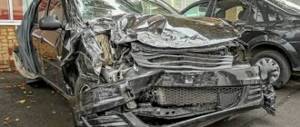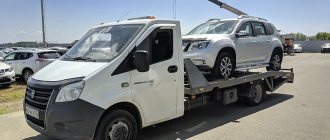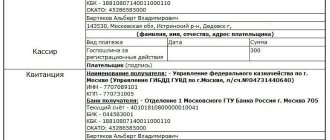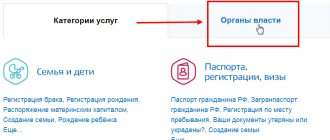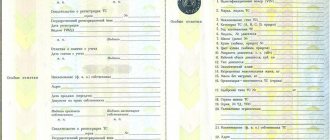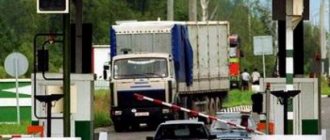Checking the car's history
By the time you buy a car, you should have checked its history at least twice: at the first inspection and before finalizing the transaction. If you have not done this yet, then you need to urgently correct the situation. Even if you have a purchase and sale agreement and a receipt for payment, you will not be able to register the car with the traffic police and legally drive it if restrictions on registration actions are imposed on it, it is on lease, wanted or has been disposed of.
Alexander Gusev, auto lawyer: “Buyers of used cars usually face legal problems. Despite this, buyers of new cars are not immune from encountering scammers. Under the guise of a new car with zero mileage, “gray” car dealerships can sell a car as collateral after an accident or theft. Therefore, I advise checking both used and new cars for legal purity.”
You can check your car's history from home on the website. The service collects information about the legal and technical condition of the car from 16 databases (state traffic police database, Federal Tax Service, Federal Customs Service, collateral register, banks, insurance companies, taxi registers, etc.). You can check the car by VIN or license plate number. In the screenshot below you can see what a report with auto history looks like. Follow the link to see an example of a full report.
The cost of the report is 349 rubles. In addition to legal nuances, the report will show the history of accidents, calculations of repair work, mileage history, service history and technical inspections.
Also read: All about traffic police restrictions
You bought a used car second hand
A used car requires much more attention and effort than a new car from a showroom. It is not the first year, it has some wear and tear on its components, it has been repaired in some places, it may have been involved in minor accidents, many parts have been replaced, and some still require replacement.
Now you are its owner and are responsible for its safe operation, which means you must show maximum attention from the very beginning. Before you go on the road, you need to:
Register a car and get MTPL insurance
Within 10 days from the date of concluding the purchase and sale agreement, you need to resolve the issue with the compulsory motor insurance policy (MTPL) and re-register the car in your name. You cannot drive with the insurance and registration of the previous owner for any longer, since the first traffic police inspector who stops you will issue a fine.
Therefore, start by purchasing compulsory motor liability insurance in your name and registering the car with the traffic police in order to receive a new STS. Beforehand, even at the stage of signing the contract, we also recommend checking the legal purity of the car, so as not to accidentally end up the owner of a stolen, pawned, “criminal” or damaged car. Particular attention is paid to the body and engine numbers: they must match on the units and in the documents.
Carry out a comprehensive diagnosis of the technical condition of the machine
If the car is not new, it naturally can present you with many surprises. Therefore, diagnostics of the leading systems of the car must be carried out even before the fact of its purchase. But if you couldn’t do it right away, don’t be lazy to do it now.
To carry out diagnostics, it is better to choose a professional service station that has the necessary stands and equipment for in-place diagnostics. Both your safety and the amount of money needed to bring the car to completion will depend on the accuracy of the diagnosis received.
Replace filters
Filters, like cleaning elements of leading systems, should be changed at every maintenance. Do not trust the previous owner’s assurances that “he replaced everything before selling it,” and install new air, fuel, oil filters, as well as a transmission filter and a cabin filter. Firstly, you will be protected from the sudden failure of one of the car systems, and secondly, you will now be able to independently control the timing of their subsequent replacement.
Read the car owner's manual
The vehicle's owner's manual is usually given to the new owner along with the vehicle. If it is not included in the kit, you can buy a new copy and quickly familiarize yourself with the main features of the brand and model of the machine you purchased, standard operating volumes of technical fluids, intervals between maintenance cycles, etc.
Wash and clean the car
Usually, before selling a car, the owner of a car performs a superficial cleaning and washing of the car, but you should do it again, only more thoroughly - take it to a car wash and wash it, and carry out a comprehensive cleaning of the interior and trunk. At the same time, you will be able to detect any defects and flaws that the previous owner missed or hid from you.
Replace technical fluids
All technical fluids - oil, water, antifreeze - must be completely replaced, as well as filters. It is not known what quality of fluid the previous owner filled in, and the serviceability of the leading systems of the machine and the safety of its operation depend on this.
In addition, it is unlikely that the seller changed them before the sale, and after replacing you will know exactly what you put in the car, and from what moment you start counting the time frame for the subsequent planned replacement.
Replace worn parts
Naturally, you did not buy a car in order to immediately begin serious repairs and replacement of spare parts - you bought a car to immediately start using it. But this does not prevent you, immediately after purchase, from starting to gradually change everything that needs replacing, but does not require serious investments and labor costs.
First of all, you should pay attention to the parts that are in front of your eyes and are obviously worn out - spark plugs, indicator lights on the dashboard, windshield wiper blades, floor mats, etc. This will allow you to further “refresh” and improve the condition of the machine, reduce subsequent complex costs and the amount of future maintenance and repair work. Some expenses are best done gradually.
Check the brake system
Car brakes are the basis of your safety, especially if the car has a lot of mileage and wear. The condition of the brake system cannot always be accurately determined immediately - it is necessary to check them dynamically when the car is in motion. A preliminary inspection can only conditionally determine the level of brake pad wear and the sensitivity of the brakes to pedal pressure.
It is better to carry out the check not on the road, but in a safe area where you can test the car in different modes, speeds and maneuvers. If you don’t like the way the brakes react to your steering, immediately take your car in for brake system repair and brake pad replacement.
Check the condition of tires
Another important element of operational safety is car tires, which are often worn out on most used cars. And wear (bald tires) means poor grip and instability when maneuvering.
Therefore, it is important to evaluate the tread depth of the tires and the absence of hernias. If the tire is in doubt, it is better to replace it (it is better to change it in pairs). In addition, it doesn’t hurt to take the car to a service station to check not only the condition of the tires, but also the correctness of the wheel alignment settings.
In conclusion, after purchasing a car, you need to complete some mandatory registration procedures and service work before hitting the track. Your safety while driving, as well as the serviceability and service life of the car, will depend on how carefully and thoroughly you follow the recommendations listed above.
And remember, a used car with mileage requires much more attention than a new car just bought at a car dealership, more thorough diagnostics and service.
We undergo technical inspection
This point is not relevant for everyone. You need to undergo a technical inspection if the vehicle diagnostic card has expired. Without a valid diagnostic card, you will not be able to obtain an MTPL policy. If the card is valid, then you do not need to reissue it: a change of owner does not affect it.
Since only ten days are given for maintenance, issuing a policy and registering a car, we recommend checking in advance whether the car was serviced by the former owner. To do this, punch in the vehicle’s license plate number and in the “Technical Inspection” block of the avtocod.ru report, look at when the maintenance expires.
An MTPL policy can be issued even on the last day of the maintenance period. If the period has expired, you will have to service the car yourself. This can be done at specialized technical inspection stations.
You can undergo MOT in any region of Russia, regardless of your place of residence. For inspection, in addition to the car, you will need a passport, PTS or registration certificate. The cost of a technical inspection, depending on the region, ranges from 300 to 1,000 rubles. You make payment at the station.
Also read: Car technical check: step-by-step instructions
Selecting a car, what details to pay attention to before paying
You can buy a car yourself or entrust the matter to specialized offices. The selection service is paid based on the volume of work, size and reputation of the company. If you decide to entrust the selection of a vehicle to a company, find reviews, read forums, find out about its reputation from friends. Do not rush to conclude an agreement with the first organization you come across. If you pay, choose experienced business representatives with years of work behind them and many completed transactions. A hired company will accompany you for a fee to the doors of the traffic police department and you don’t have to read any further!
If you decide to make the choice and design of the car yourself, we continue.
Select the make and model of the car that interests you. If the model is sold in car dealerships, go and take a test drive to confirm your choice. If a friend has the device you want, don’t hesitate to take it for a ride. Support or refute your choice.
We’ve decided on the model, let’s move on to searching for the right copy on the secondary market.
Visit car dealerships that accept used cars, ask your friends, perhaps a friend is planning to upgrade his car. There are many cars on specialized Internet sites. When selecting remotely, immediately exclude the following options:
- Below the average market price by 20% or more;
- With prepayment so that “the car doesn’t go away”;
- Sellers who refuse to provide a VIN.
Write down a few applicants and conduct an inspection. If your personal level of technical training is minimal, call a friend who understands it, or an expert for money.
Technical inspection
You can get diagnostics from an official dealer or an independent service center. A check at a car service center will identify possible technical problems and allow you to reduce the purchase price.
When conducting an examination to exclude collusion, we do not recommend contacting car services offered by the seller.
When diagnosing yourself, check at least:
- The lift has corrosion and holes in the underbody
- The presence of cracks, deformations and damage on elements reinforcing the vehicle structure (spars);
- Leaks of fluids in the gearbox, axles (if any), engine, brake and cooling systems;
- The gaps between the doors, hood, trunk - the factory distances are the same on both sides; if not, there is a possibility that the car was in an accident and the part was removed;
- Check the paintwork using a thickness gauge - rent it;
- Check the fastenings of opening elements (for example, doors) at the fastening points - traces of unscrewing indicate adjustment or removal of the part;
- In the trunk, inspect the space for the spare tire and the hardware under the carpet - cheap repairs may leave deformation and/or traces of paint.
Check the condition of the interior - scuffs on the steering wheel, driver's seat, armrest, how clean and well-maintained the interior is. By the level of wear you can judge the reality of the mileage. The level of dirt indicates the cleanliness of the owner.
There are no scuffs to the ground with a mileage of 50 thousand km.
Checking vehicle and owner papers
Before buying a car in person, check the history of the car and the owner, and the availability of a set of documents.
For a young (2-5 years old) car, ask for a service book. To maintain the dealer warranty, the owner is required to carry out maintenance according to established rules. Avoidance of maintenance will result in loss of warranty. Ask how the car was serviced, what was changed, if there are receipts. If the oil on a one-year-old car is changed in the garage, the owner clearly saves on servicing the “swallow”.
Request a title from the seller. If the car is new (3-5 years), the passport must be without a duplicate mark. The presence of such an inscription indicates that a new vehicle passport has been issued to replace the previous one (and not necessarily the first one).
Fraudsters use a similar scheme when selling credit cars. The bank leaves the passport for the car in the safe (not always), enterprising swindlers, upon application to the traffic police about the loss or damage of the registration certificate, restore it and sell the car. In the future, the bank requests the collateral from the new owner, and the buyer risks being left without money and without a vehicle. The scheme was used because there was no common base of car collateral.
Since 2014, the process of compiling a comprehensive all-Russian database of pledged cars began. Paid and free services have appeared to check whether a vehicle is in collateral. For example, the website of the Federal Notary Chamber.
Information about the vehicle history is available on the traffic police website by VIN code:
- number of owners;
- Road accidents for which traffic police officers were called;
- the presence of prohibitions and restrictions on registration actions and the authorities that established the restriction.
If there are restrictions on registration, you will not be able to register the car in your name, just as if it is prohibited.
When purchasing a vehicle in the passport, the seller is required to sign; if there is no free space, the previous owner changes the title, and without it a new document will not be issued. Pay attention to this.
The car is in order - we go to the owner.
Before making a purchase, check the owner’s passport; if the car is being sold by proxy, check the original document. If during communication a person answers questions evasively and does not provide the information that is needed, you should think about buying from this seller.
On the FMS website, make sure the owner’s passport is valid. On the website of the traffic police and bailiffs, check unpaid fines, alimony and other penalties imposed on the owner. The debt existing at the time of purchase may turn into a limitation of registration actions. If during the time from signing the contract for the purchase of a vehicle to registration, the bailiffs impose a restriction, it will take time to clarify the situation and remove the encumbrance. In such a situation, if you don’t want to give up purchasing a car, go to the traffic police together with the old owner.
Read more about document verification in the article.
We receive an MTPL policy
Every car owner must have a compulsory civil liability insurance policy (MTPL). Without it, it will not be possible to register the car with the traffic police. You can operate the car with insurance issued to the previous owner. But! Only 10 days after purchase (from the moment the purchase and sale agreement was signed). After this period, the fine for using a car without compulsory motor insurance will be 800 rubles.
Also read: How to apply for compulsory motor liability insurance when buying a used car
Checking the steering and transmission
- Checking the operation of the gearbox to ensure that the position of all gears is locked,
- Checking the hydraulic or electric power steering without turning on the ignition and with the engine running,
- Checking the operation of the hand brake.
If any of the above has deviations in performance or any inconsistencies, then there is no need to immediately attack the manager demanding compensation or, in general, replacement of the machine. You need to complete the entire inspection to the end, with marks on your checklist, and upon completion, look for a compromise option that would suit both parties.
If agreement is reached and the car dealership has compensated for the shortcomings, then you can sign the Transfer and Acceptance Certificate indicating the comments. The manager must return one copy of the act to the buyer.
That’s it, this is where the procedure for picking up a car from the dealership ends and you can drive your own car closer to home.
Website editors
Publications on the topics: how to get a car loan, which car to choose for credit, conditions for car loans in banks for new and used cars, how to repay a car loan ahead of schedule, CASCO and MTPL insurance for a loan car. The editors of the “Car on Credit” website help you understand the issues of obtaining, repaying and servicing a car loan
Was this publication useful to you?
Bookmark it on social networks!
Total score: 4Votes: 193
Got into an accident with a new car - insurance payments in case of an accident
A new car from a showroom - rules for buying a car at a showroom
We recommend other useful posts on this topic:
Car warranty - car repair under warranty, maintenance of a warranty car
Small cars for women - how to choose a safe women's car
How to choose a first car for a novice driver - which first car to get
Loan for car repairs - how to repair a car on credit
9 Tips for Used Car Buyers - Inspecting a Used Car
Tax on income when selling a car less than 3 years of ownership
Registering a used car with the traffic police
The new owner is required to register the car with the traffic police within 10 days after purchase. You can register a car at any traffic police department, regardless of your place of actual residence and permanent registration.
To register with the traffic police you need to provide a package of documents:
- registration application;
- passport;
- PTS;
- contract of sale;
- state registration plate (if available);
- MTPL policy (it is not necessary to present the original - a copy is sufficient).
In a situation where the car is registered not by the buyer himself, but by his representative, it is necessary to have a power of attorney with him.
The procedure for registering a car includes the following steps:
- submitting a package of necessary documents to the traffic police;
- visual inspection of the car by a representative of the State Traffic Inspectorate;
- issuance of license plates and vehicle registration certificates.
You can sign up to register a car with the State Traffic Safety Inspectorate through the State Services portal. There you can pay the fee for registering a vehicle online with a 30% discount.
Also read: Rules for registering a car with the traffic police
Procedure for registration of PTS in 2021
After the parties draw up an agreement, it is necessary to make appropriate changes to the PTS. You may encounter a situation where there is no space in your passport for a new entry. In this case, you must contact the traffic police with an application for a new PTS. After checking the old document with the electronic database, employees will issue a new PTS. After these steps, the parties can exchange keys and money. The safest option to pay for your purchase is to transfer funds by bank transfer. This is the option that the buyer must initially offer to the seller. After the transfer, the financial institution will issue a corresponding check, which is documentary evidence of the transfer of funds.
( Video : “How to correctly read the PTS Vehicle Passport (Tips from RDM-Import)”)
Handing over the keys and passing the technical inspection
Of course, the parties have the right to independently choose how and when the seller will hand over the keys.
But it is customary to do this after all the paperwork has been settled and the funds have been credited to the seller’s account. In addition to the keys, the buyer must receive a purchase and sale agreement, a registration certificate, and an acceptance certificate, if one has been drawn up. As a rule, along with the car, the buyer receives a diagnostic card, which indicates that it has passed the inspection. However, the seller does not always have this document. For example, he has not been inspected for a long time, due to the uselessness of the car. In fact, the car just sat in the garage for a long time. In such a situation, the new owner will have to deal with this procedure independently. The technical inspection can be done at any accredited company.
We put the technical condition of the car in order
When the issues with the documents are settled, it’s time to put the technical condition of the car in order.
- Replace the air, fuel, oil and cabin filters, as well as the gearbox and engine oil, coolant and brake fluid, and special fluids in the components.
- To prevent the car from pulling in different directions when driving, to reduce fuel consumption and prevent early tire wear, get a wheel alignment.
- Visit a tire shop to have your wheels balanced.
- For cars older than 7 years, it is important to replace crankshaft seals, gearboxes, and gearboxes.
If, before purchasing a car, you did not inspect it at a service center, including using a lift, we advise you to do so immediately after purchase. This will help avoid unexpected problems in the future.
Weed out dubious ads
Write down the characteristics of the desired car and the maximum amount you are willing to pay.
To simplify your search, use filters on sites with for sale advertisements. Questionable offers can be identified based on several criteria. You need to leave a deposit or prepayment.
If you are offered to make a deposit or an advance payment so that the car is not sold, do not agree. This is what scammers do.
The price is too low.
If a car costs 2-3 times cheaper than similar options, be wary. This could be a car without documents, in collateral or with limited registration. They greatly underestimate the price of stolen cars and “shifters” - cars after an accident, assembled in parts.
Foreign numbers.
If the car has foreign plates, it will be difficult to register it. Often such numbers turn out to be fake, and the car is listed as stolen. When registering with the traffic police, the car may be confiscated - then you will be left without money and without a car.
Numbers from another region.
The situation is similar with license plates from another region - the car can also be reported stolen. Find out why the seller is selling the car in another region. Carefully check the documents of the owner and the car.
No documents.
If the seller shows a duplicate of the certificate, vehicle passport, and the MTPL policy lists a bank or credit institution as the insured, the car is pledged. Ask the owner to provide the original PTS: if there is no document, this is a reason to refuse the deal.
Registration ban.
If the ad says the car has registration restrictions, don't buy it. The former owner could scrap the car and then sell it to you - such a car will no longer be registered.
If you find a suitable ad, arrange an inspection of the car.
